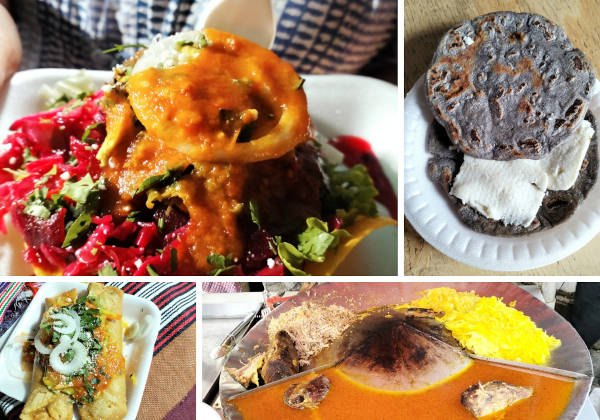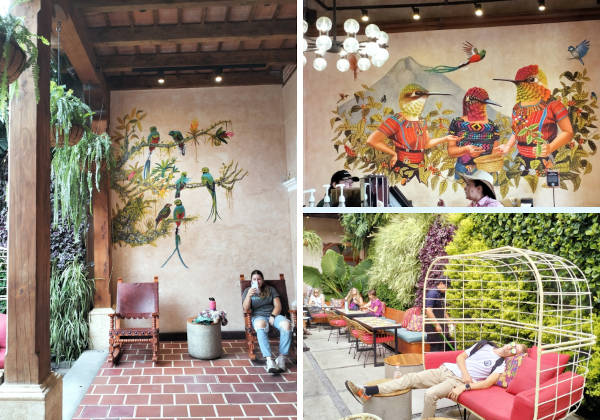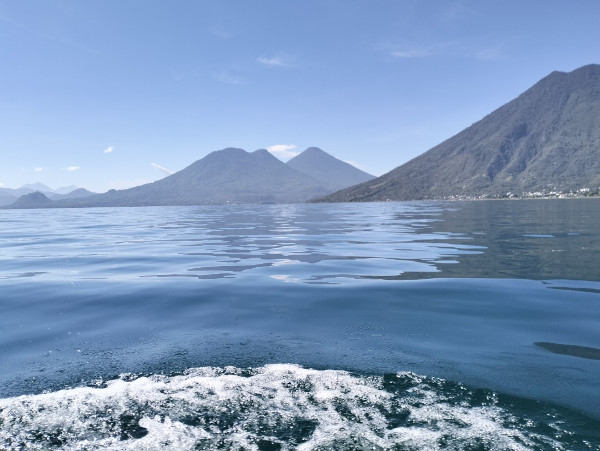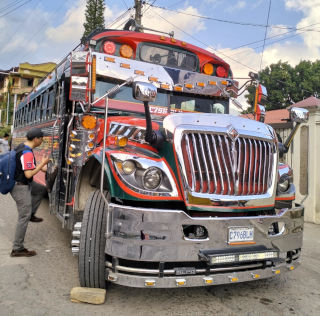[Clockwise from top: A street mural, a chicken bus, a street in Antigua, Guatemala]
Wobbling like a penguin, trying to find my balance on the mediaeval cobblestone roads of Antigua in Guatemala, I was forced to slow down and get more observant of life at every step of the way. This was the perfect beginning of my three-months-long slow travel experiment through Guatemala, Mexico and California.
Typically, slow travel would mean staying in one place for a few weeks. But faced with the challenge of being on long flights and buses every few days, I decided to stretch time between other activities to create expanded pockets of time.
Would this conscious slowing down lead to heightened states of awareness and a better understanding of this world of Maya?
Guatemala, the land of the Mayan people, was an interesting portal to go deeper into the rabbit hole of alternate realities.
When a sweet couple offered me a chewing gum on the flight to Guatemala City for air sickness and a security officer kindly shared his Wi-Fi hotspot since all mobile kiosks were closed when I arrived late at night, I felt myself slipping into a certain ease of existence even before I stepped out of the airport.
Blog posts by an English lady who shared stories of her daily life in a village in Guatemala inspired my visit there.
Imagery of chicken scurrying around her log cabin in the woods, corn roasting on wood fire, soaking in energy at Lake Atitlan's volcanoes and legends of Mayan pyramids tucked in forests were so evocative. They offered a different view compared to Central America’s stereotypical image of Nachos and Narcos.
Antigua Guatemala
Seasoned travellers to Guatemala advised that from a safety perspective, I should skip Guatemala City and head to Antigua. Years of safe solo travel through tricky terrain has taught me to assess risk differently. I would have loved to visit Guatemala City. But to minimise hotel check ins, I decided to base myself in three main towns and do day trips from there.
Every wobbly step in Antigua past cotton-candy-coloured houses felt like I was walking into a time warp. Two eras seemed superimposed. One, fast paced that stimulates the senses. The other, slow and soothing for the senses.

[Antigua Guatemala is also the main transport hub for Latin America]
Only the sound of fast-paced yet soothing clapping of hands as women flattened tortillas balanced time between two opposing timelines like a metronome.
The clatter of horse carriages here mingled with the zooming of modern-day cars. Ancient ruins formed the backdrop of modern rock concerts.
Somewhere at this juxtaposition of two different rhythms, I was hoping to rediscover myself.
Food was a highlight. Brunch was usually at the exotic food stalls outside the central church selling finger food like tortas, panuchos, cochinita pibil, El Salvadoran papusas, etc.

[Food was a highlight: From traditional meals to street food]
Full course meals were Comida Typicales (traditional food) consisting of tortillas, rice, assortment of meat, fried plantain, and baked beans, all washed down with Horchada, a refreshing rice drink.
Guatemala’s famous artisanal coffee at the modern Starbucks in Antigua, housed in a grand vintage mansion, was the perfect spot to reflect on my experiments with time.
Colourful Mayan wall art of kings wearing grand headgear formed an interesting background for cap wearing, Wi-Fi seeking travellers lounging by a fountain in a central open courtyard. Here I connected with locals and travellers who later showed me interesting spots in town.

[My favourite hangout, Starbucks in Antigua, is housed in a vintage mansion]
As I sat around watching people, I was amazed at how similar Guatemalans and Indians looked. Sometimes, drifting out of my thoughts, I had to consciously remind myself that I was not sitting at a Starbucks in Mumbai.
How was it possible that people from two different regions, halfway across the world, looked exactly the same? Every time someone asked me something in Spanish and I would revert with “No Espanol” and reveal that I am Indian, we would both stay silent and look at each other like mirrors. Somewhere in the seeming similarity, yet obvious dissimilarity of the other person, we both sought answers about our own identity.
In Sanskrit, Maya means illusion. I suddenly felt like I was standing in a room of mirrors looking at many versions of myself, seeking to understand the one timeless question: Who am I?
To go deeper into this question, I had to trade zipping around mindlessly with a more mindful exploration.
Just before my flight from Los Angeles to Guatemala City, I had stumbled upon a book called The Little Book of Sloth Philosophy at an airport book shop. Interestingly, sloths are from Central and South America and embody mindfulness in action. They were perceived as lazy and useless, till it was discovered that their lifestyle has several important benefits like reducing stress and illness. The fact that they have been around for tens of millions of years is testimony to their slow-paced timeline.
On this trip, I decided to explore new ways of being and reduce my activities to a bare minimum. Could I stretch an activity that can be finished in 10 minutes to an hour? Is it time wasted or does it create new neural pathways for my mind to experience things differently? As my experiments with time progressed, things turned very intriguing.
I suddenly found myself dealing with a very different force field and started experiencing things that other co-travellers were not experiencing.
For example, at the pyramids of Tikal (the oldest MesoAmerican pyramids of Central America), I was struggling to keep up with the four-hour rapid sprint that our guide took us on. As we zipped around the different pyramid groups in the dense forest, a foot injury slowed me down and I walked at my own pace.

[At Tikal]
Just after everyone had walked ahead, I had a rare sighting of a colourful Toucan looking for its fledgeling.
Around the next corner, I spotted some adorable raccoons foraging for food. I had come here to see the pyramids, but nature clearly wanted me to pay attention to the wildlife of the Tikal biosphere, one of the largest green belts of America.
Looking down, I got an ego check as I spotted some ants diligently carrying little leaves to a tiny earthen pyramid they had built. They had used the same principles of sacred geometry as the massive man made pyramids. While for ants this was routine business, for man there is ego attached to what they create.
From Egypt to Guatemala, pyramids around the world are symbolic of man’s achievements and also their destruction. I paused to reflect on how all mighty civilizations that have built pyramids have disappeared without a trace.
A little further down, I saw a crocodile sunning itself near a water body. Looking at its still body and half closed eyes, I marvelled at how its deceptively calm meditative pose was just a predator waiting patiently for its prey. Yet, there was something marvellous about this duality.
When I showed photos to my co-travellers later, I figured none of them had these experiences or insights. This was a direct validation from the universe of the benefits of slowing down and surrendering to nature to reveal her treasure trove.
Unplanning
To further probe the workings of the universe, I had decided to keep my trip unstructured. This was, of course, backed up with being in touch with locals and contingency backup plans. Misadventures and avoidable problems were not on my menu. There was a method in the apparent madness of solo travel through Spanish-speaking Central America without a fixed itinerary.
I would research destination options and hotels so I knew my options well. I also used travel networking sites like Couchsurfing for insider access to travel tips and meeting locals.
I was curious to see what happens when I wake up in the morning not knowing where I would go next. Once again a new force field emerged and itineraries revealed themselves to me in interesting ways.
After a drive from Antigua to San Pedro on a rainy morning through the hills, a local friend suddenly called to say she has organised a hotel for me through a series of serendipities. My room probably had the best views in town. Sunrise from my window over the volcano-fringed, luminous waters of Lake Atitlan—considered to be mystic—was a sight to behold.

[Lake Atitlan]
My typical day would start with hot chocolate at a cafe overlooking the pier and then relaxing ferry rides to different surrounding islands.
San Marcos island is popular with tattooed young seekers sipping herbal teas in conscious cafes with posters for full moon meditation classes. While traditional Shamans danced to their own beats.
The island of San Juan decorated with colourful aerial umbrellas is the go-to place for artisans selling colourful clothes and artefacts.

[At San Juan]
On another serendipitous Sunday morning, while relaxing on a rocking chair outside my room, I met a young girl who was going to Chichicastenango market, the largest open air market in Central and South America. This is a bi-weekly market and I suddenly figured this was the only day I could make it happen because I was most likely leaving in a couple of days.

[Handicrafts at Chichicastenango market]
Since direct shuttles had already left very early in the morning, I had to take the more adventurous route with six bus rides and two boat rides for the return journey. During the boat ride to Panajachel, the last ferry stop, it was lovely to see how locals celebrated their Sunday morning with traditional music on harps.
Local tribal folk greeted me on the chicken bus ride up the hills. They probably thought I was local.

[A chicken bus]
Chichicastenango market was a riot of colours as tribal women displayed their beautiful collection of handicrafts and dished out corn in cream and tortas. At the local church there, I was offered a Shaman ceremony. While I was curious, I had to politely refuse as I had to get the boat back.
Sitting on the edge of a seat on the tiniest possible space on a crowded chicken bus headed to the pier, I figured it's experiences like this that will stay with me forever.
Guatemala felt like an ocean of churn where the sum total of me was ripped apart in many ways and reframed. I was pushed to test my limits so I could understand aspects of myself with greater clarity.
Maya
Ironically, in the land of Maya, while I explored the illusory nature of reality hoping to transcend it, I understood the benefits of this worldly Matrix.
Sometime back I learnt that the root word for Matrix is “Matr” or mother. While both men of spirituality and science have always talked of exiting or hacking the Matrix as if it's an evil algorithm in which we are trapped, this trip has taught me to make peace with this mother energy field that weaves necessary illusions for our survival and evolution.
And then when the time and level of awareness is right, the same mother force that weaves the veil rips it off and helps us get closer to our real self.
My journey through Mayan Guatemala taught me that Maya, like my own self, will always remain a mystery. It cannot be fully understood, only accepted and respected.
Travel Tips for Guatemala

[New friends on the journey]
Visa: A US visa is valid for entry into Guatemala and most other Central American countries.
I was told a combined visa is issued for Guatemala, Nicaragua, Honduras and El Salvador. If you get a visa at any of these countries, you can travel to other countries in the list for the visa duration.
Flights: I found flights from Los Angeles to Guatemala the most reasonably priced as compared to other US hubs.
Antigua Guatemala: Antigua is the main transport hub for Lake Atitlan, Flores and other countries like Nicaragua, El Salvador, etc. They are all in different directions. I opted for a 12 hour+ bus to Flores and then crossed over to Mexico over land. Another traveller I met took the land route to El Salvador, Nicaragua and Costa Rica.
Language: I managed with English and a few words of Spanish for basic conversations. But for complex communications like booking bus tickets, definitely use Google translate to avoid any misunderstanding. I preferred booking bus tickets from local travel agents so that they could explain everything to me properly. Booking online with limited Spanish knowledge can be cumbersome.
Tikal tour: At Tikal, the group guided tour was very rushed. The route, though in a forested area, is well marked out and has several travellers. If you want to spend more time at the pyramids, definitely do it on your own or with a private guide.


